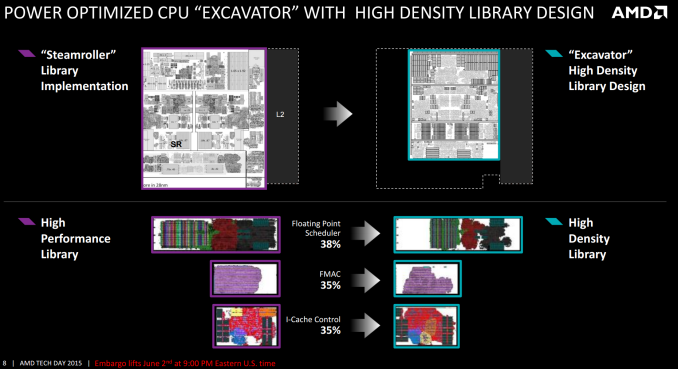AMD Launches Carrizo: The Laptop Leap of Efficiency and Architecture Updates
by Ian Cutress on June 2, 2015 9:00 PM ESTThe Platform
From a design perspective, Carrizo is the biggest departure to AMD’s APU line since the introduction of Bulldozer cores. While the underlying principle of two INT pipes and a shared FP pipe between dual schedulers is still present, the fundamental design behind the cores, the caches and the libraries have all changed. Part of this was covered at ISSCC, which we will also revisit here.
On a high level, Carrizo will be made at the 28nm node using a similar silicon tapered metal stack more akin to a GPU design rather than a CPU design. The new FP4 package will be used, but this will be shared with Carrizo-L, the new but currently unreleased lower-powered ‘Cat’ core based platform that will play in similar markets for lower cost systems. The two FP4 models are designed to be almost plug-and-play, simplifying designs for OEMs. All Carrizo APUs currently have four Excavator cores, more commonly referred to as a dual module design, and as a result the overall design will have 2MB of L2 cache.
Each Carrizo APU will feature AMD’s Graphics Core Next 1.2 architecture, listed above as 3rd Gen GCN, with up to 512 streaming processors in the top end design. Memory will still be dual channel, but at DDR3-2133. As noted in the previous slides where AMD tested on DDR3-1600, probing the memory power draw and seeing what OEMs decide to use an important aspect we wish to test. In terms of compute, AMD states that Carrizo is designed to meet the full HSA 1.0 specification as was released earlier this year. Barring any significant deviations in the specification, AMD expects Carrizo to be certified when the final version is ratified.
Carrizo integrates the southbridge/IO hub into the silicon design of the die itself, rather than a separate on package design. This brings the southbridge down from 40nm+ to 28nm, saving power and reducing long distance wires between the processor and the IO hub. This also allows the CPU to control the voltage and frequency of the southbridge more than before, offering further potential power saving improvements. Carrizo will also support three displays, allowing for potentially interesting combinations when it comes to more office oriented products and docks. TrueAudio is also present, although the number of titles that support it is few and the quality of both audio codecs and laptop speakers leaves a lot to be desired. Hopefully we will see the TrueAudio DSP opened up in an SDK at some point, allowing more than just specific developers to work with it.
External graphics is supported by a PCIe 3.0 x8 interface, and the system relies on three main rails for voltage across the SoC which allows for separate voltage binning of each of the parts. AMD’s Secure Processor, with cryptography acceleration, secure boot and BitLocker support are all in the mix.












137 Comments
View All Comments
FlushedBubblyJock - Tuesday, June 9, 2015 - link
they probably have their contrast off, clear type disabled, the wrong screen font, smoothing edges of fonts disabled, then he's probably a far sighted coke bottled glasses with bifocals... thus amd must be had in dooper high rezz at 14fps...meacupla - Wednesday, June 3, 2015 - link
Ideally, what you'd get is a 2560x1440 screen with PROPER scaling to 1280x720, unlike what most monitors seem to do, which is a terrible job at scaling.SilthDraeth - Wednesday, June 3, 2015 - link
I run a Kaveri on my desktop and it drives 1080p just fine. Anyways, most intel laptops in that same range run 1366x768 screens also. At least almost every laptop you find in a Staples, or a Walmart. Very few of the devices on display have a higher resolution screen, or IPS solution.yankeeDDL - Wednesday, June 3, 2015 - link
Yes, *and* Intel's in that price range don't run games.FlushedBubblyJock - Tuesday, June 9, 2015 - link
yes they do make sure you have hd3000 at least but that's cheap as beansMargalus - Wednesday, June 3, 2015 - link
how is it an "issue that plagues AMD"? Are you saying AMD chips are buggy and crash at that resolution? Are you saying AMD graphics get corrupted at that resolution?medi03 - Thursday, June 4, 2015 - link
Ditto.In fact, 1366x768 TN (!!!) screen is the main issue with AMD mobile chips.
Drumsticks - Wednesday, June 3, 2015 - link
The 45W A8-6500T scores 71 in Cinebench R15. Even assuming that 15W kaveri gets identical performance (I couldn't think of a 15w kaveri chip to check on bench) that puts it at 106, which is finally, finally even with broad well in the xps 13, or at least <10%.Skylake will probably add another 10% gap, but this is the closest AMD might be in the last seven years or so to catching up with Intel. And at half the price, they could seriously have the start of a comeback!
xenol - Wednesday, June 3, 2015 - link
My only problem with AMD and the marketing blurbs is that they're targeting niche markets for all intents and purposes. Despite what PC gamers want us to think how big PC gaming is, it's not exactly a majority player in the entire scheme of things and gaming on a laptop isn't really that accepted.And even if gaming is involved, it's usually not games that require beefy specs to begin with.
Michael Bay - Wednesday, June 3, 2015 - link
PC gaming by marketshare is on par with any pastgen/nextgen console and sometimes more than one.